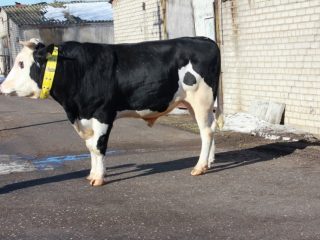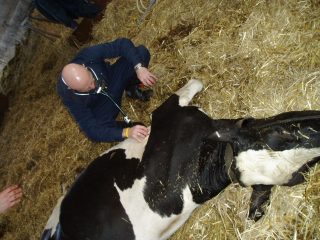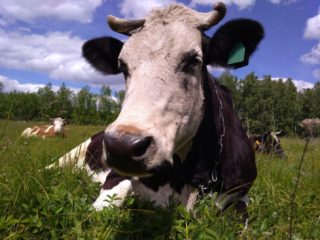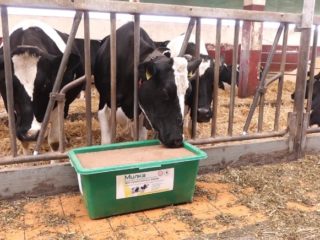Content
Diarrhea in a cow after calving is so common that many owners consider it normal. Of course it is not. A digestive disorder should not be related to the birth of offspring, otherwise female animals would not survive in nature.
Why does a cow have diarrhea after calving
The causes of diarrhea in a cow after calving can be infectious or caused by metabolic disorders:
- ketosis;
- acidosis;
- alkalosis;
- eating the placenta;
- postpartum sepsis;
- enteritis;
- helminthiasis;
- allergy;
- hormonal jump.
It is quite easy to disturb a cow's digestion. At the hotel, the uterus can eat the released afterbirth. While this is normal for carnivorous mammals, the placenta can cause severe stomach upset in herbivores. This is largely due to the fact that there are a lot of hormones in the tissues of the child's place. And the stomach of herbivores is not adapted to eating large amounts of animal protein.
Also, according to the observations of livestock breeders, diarrhea can occur after the cow has drunk sweet water. Here the owner finds himself between a rock and a hard place. Soldering sugar dissolved in water is recommended for the prevention of postpartum paresis. But a large amount of easily digestible carbohydrates provokes rumen acidosis. As a result, the cow develops diarrhea after calving. But it is not always possible to guess with the dosage of sugar syrup in order to “walk along the razor's edge”.
What is the danger of diarrhea in a cow after calving
Immediately after the birth of a calf, the cow needs a lot of liquid: she needs not only to "provide" her own soft tissues with water, but also to give milk to the baby. That is why, after the birth of offspring, any pets are recommended to first of all give warm water.
Diarrhea, especially severe, dehydrates the body. As a result, the uterus will not have enough moisture either to produce milk for the calf or to meet its own needs. The calf left without food is not so bad if the owner has other dairy cows. But with severe dehydration, animals die, and the result of diarrhea can be the death of livestock.
Since diarrhea is the result of a violation of the digestive tract, then, in addition to the loss of moisture, pathogenic microflora begins to develop in the intestine.
What to do if a cow has diarrhea after calving
Given that dehydration occurs very quickly with diarrhea, it is necessary to treat diarrhea in a cow after calving when the first signs of an illness appear. You shouldn't expect that everything will suddenly work out by itself. First of all, all juicy and concentrated feed is excluded from the cow's diet, leaving only hay.
With diarrhea, most often only symptomatic therapy is possible, since the cause must be treated, not the symptom. But the elimination of the symptom also relieves the cow's condition and contributes to her recovery. You can stop diarrhea after calving with medication or traditional methods. The first is more reliable, the second is cheaper and often more affordable.
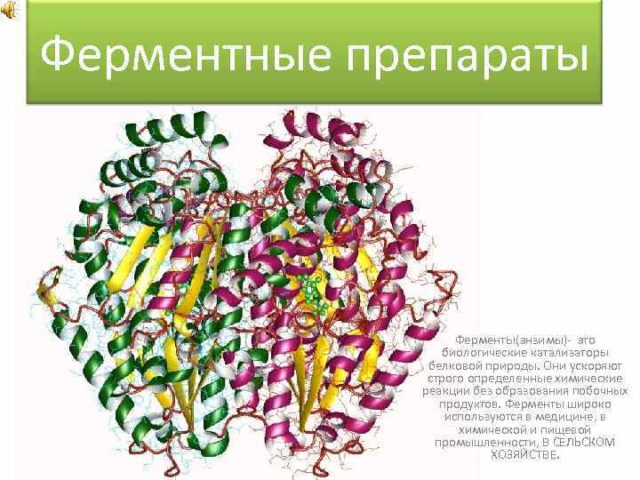
In some cases, enzymes can help relieve diarrhea after calving, but sometimes other remedies are needed
Medical treatment for diarrhea in a cow after calving
It makes sense to use antibiotics for diarrhea if they are aimed at treating the underlying disease.To regulate the reproduction of pathogenic bacteria, drugs are used only in the case of advanced diarrhea, when dysbiosis has already begun. To destroy harmful microflora in the gastrointestinal tract, antibiotics of the tetracycline group are mainly used. You can also use sulfa drugs. But the dosage in any case should be set by the veterinarian. Especially considering that the cow after calving and must feed the newborn.
For symptomatic relief of a cow with diarrhea, use:
- electrolytes;
- saline;
- glucose solution;
- drugs that slow down peristalsis;
- enzymes;
- probiotics.
Electrolytes allow you to restore the water-salt balance, which is disturbed in case of profuse diarrhea. They are released in the form of powders that must be dissolved in water. They have a rather complex composition, and it is impossible to prepare the electrolyte on your own. Not everyone may have a sachet of the finished product at hand.
As a first approximation, the electrolyte can be replaced with a solution of ordinary table salt at a concentration of 0.9%. This is the concentration of non-sterile saline solution. You cannot drip into a vein, but you can forcefully drink 2 liters.
Sorbents are used to remove and bind toxins formed in the intestine. The most commonly used are activated carbon and alumina. The most readily available drug is coal.
Enzyme preparations are used in complex treatment in case of malfunction of the glands. To restore beneficial intestinal microflora, cows are given probiotics. However, there are opposite opinions about these drugs:
- a probiotic is necessary for diarrhea;
- intestinal bacteria reproduce well on their own.
In any case, there will definitely be no harm from probiotics. But usually it is not possible to achieve a visible effect from them.

Probiotics help restore gastrointestinal microflora after diarrhea
Folk remedies
To prepare a decoction for diarrhea, use:
- rice;
- oak bark;
- pharmacy chamomile;
- marshmallow root;
- tansy;
- sagebrush;
- elecampane;
- St. John's wort.
When giving St. John's wort, it must be borne in mind that the grass was not called that for nothing. In large quantities, it is poisonous. Chamomile is brewed when there is a suspicion of a bacteriological cause of diarrhea.
The most accessible and least dangerous of herbal preparations are oak bark and rice. The latter belongs to the category of products, the decoction of which can be given in any quantity without fear of overdose. For 10 liters of water, you will need 1 kg of rice, which will need to be boiled. The cooled broth must be soldered in 1.5-2 liters every 2-3 hours. In the end, you can feed the remaining thick, if the cow will eat it.
A large amount of tannins in the bark of oak can cause poisoning, so the concentration of the infusion should not be high. For 10 liters of water, 0.5 kg of bark will be enough. It is boiled over low heat for 30 minutes. Then they cool and dilute the broth with an equal amount of water. You can store it for 2-3 days, but in a cool place.
If there are dried herbs of chamomile, tansy, St. John's wort and others in the stocks, you can simply add them to the cow in the hay. But the advantage of decoctions in the supply of additional fluid required after calving.
Preventive actions
The main preventive measures are the correct high-quality diet and timely deworming. To prevent digestive upset, cows should be given only good-quality feed: free of mold and poisonous plants.
The lack of trace elements often causes a perversion of appetite in cows, and the use of not entirely edible substances - diarrhea. The correct balance of the diet for vitamins and minerals will help to avoid this problem.
Since diarrhea can be infectious, the vaccination schedule and hygiene of the pregnant cow house must be followed. Keeping the litter clean also helps prevent diarrhea after calving.

Clean bedding and quality food greatly reduce the likelihood of developing diarrhea
Conclusion
Diarrhea in a cow after calving is not at all common. It can be avoided if you follow the rules for keeping and feeding cattle.
